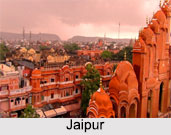 Ancient Cities of North West India include Jaipur, Jaisalmer, Jodhpur, Bikaner, Osian, Hanumangarh of Rajasthan, while on the other hand Amritsar, Patiala, Kapurthala, Nabha, Phillaur, Nakodar of Punjab, show the religion and the unification of humans through universal brotherhood. North West India traced its history of the Indus Valley Civilisation which was developed near the banks of Ghaggar River.
Ancient Cities of North West India include Jaipur, Jaisalmer, Jodhpur, Bikaner, Osian, Hanumangarh of Rajasthan, while on the other hand Amritsar, Patiala, Kapurthala, Nabha, Phillaur, Nakodar of Punjab, show the religion and the unification of humans through universal brotherhood. North West India traced its history of the Indus Valley Civilisation which was developed near the banks of Ghaggar River.
Dholpur
Dholpur has the history dating back from 700 AD, when it was established by Raja Dholan Dev Tomar of Tomara Dynasty. He resided 10 km south west of Dholpur at a place called Bilpur near Chambal where a fort still exists. Shergarh Fort and Machkund Temple are popular places of attraction.
Hanumangarh
Hanumangarh was once a well developed city in Rajasthan. It was founded in 255 AD and it was ruled by Rajputs of Bhati clan and later occupied by Maharaja Soorat Singh of Bikaner. The Kushana Empire also ruled this place.
Amritsar
 Amritsar, one of the largest cities in Punjab came into existence after Sikh Guru Ram Das bought the whole land from the landowners of Tung village.
Amritsar, one of the largest cities in Punjab came into existence after Sikh Guru Ram Das bought the whole land from the landowners of Tung village.
Jaisalmer
It is known as the "Golden City of Rajasthan", Jaisalmer is now the World"s Heritage Site crowned by a fort, which contains the palace and several ornate Jain temples. Jaisalmer is named after Maharawal Jaisal Singh. He was a Rajput king who founded the city in 1156 AD.
Bikaner
Bikaner was founded in 1486 and now it is the fourth largest city in Rajasthan. Bikaner is famed for Laxmi Niwas Palace, Karni Mata Temple and Junagarh Fort.
Jodhpur
Jodhpur is known as the "Sun City`, famous for Mehrangarh Fort, traced back during the time of coming of Aryans in India. The history of Jodhpur began from the time of Ramayana Era and flourished as a historical city in 4th Century BC. Jodhpur was founded in 1459 by Rao Jodha, a Rajput chief of the Rathore clan. Jodha succeeded in conquering the surrounding territory and thus founded a state which came to be known as Marwar.
Udaipur
The city of Palaces- Udaipur was founded in 1553, when Maharana Udai Singh of the Sisodia clan of Rajput shifted his capital from the city of Chittorgarh to Udaipur.
Jaipur
Jaipur was founded in 1726 by Jai Singh II, the king of Amer who ruled from 1688 to 1758. This city was planned according to the Hindu laws of Vastu Shastra and Shilpa Shastras.
Bhilwara
Bhilwara is the oldest part of Rajasthan that was traced back in 11th Century by Hindu kings.
Bharatpur
Bharatpur was ruled by Sinsinwar clan from the early era till the Independence of India in 1947. The Sinsinwar clan is an Indo-Sythian tribe that migrated in India around 100 AD.



















